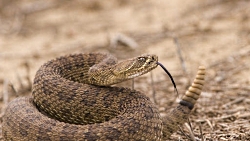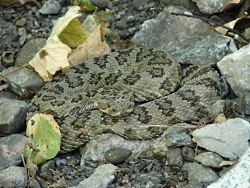Summer is here. People will be using the great outdoors more often, and that includes the many tourists who have discovered Utah’s beauty and diversity. Caution is always needed when traveling in wild country, and today I refer to an article titled “Living in Snake Country-Six Things to Consider” written by Terry Messmer, Utah State University Extension wildlife specialist.

Courtesy 123RF.com
Stephen Mcsweeny, Photographer
Licensed, Royalty-free image
Written by Terry Messmer, Utah State University Extension wildlife specialist
June 14, 2019
For many, the sight of a snake is what nightmares are made of. Unfortunately, all too often Hollywood has taken advantage of people’s fear of snakes for profit. Some companies may also market products or services that are ineffective at repelling snakes, and in some cases, these products may actually increase the risk to people and pets.
The U.S. Centers for Disease Control estimates that 6,000 to 8,000 people are bitten by venomous snake annually and that up to six snake bite victims may die. Annually, an estimated 90 human deaths occur from various venomous animal encounters. The stings and subsequent anaphylaxis from bees, wasps and hornets are responsible for over 90% of the reported human deaths.
Of the 31 species of snakes found in Utah, seven are venomous. These are commonly called pit vipers because of the pit located between their nostrils and eyes. Most pit vipers found in Utah also have tails with a series of rattles, hence the name rattlesnake.
All snakes are classified as non-game animals and are protected by Utah state law. A person cannot lawfully collect or possess a live wild snake without receiving a Certificate of Registration from the Utah Division of Wildlife Resources. When there are human, domestic pet and livestock safety concerns, a venomous snake may be killed without a certificate.
Because most snakes in Utah are non-venomous, most human-snake encounters are generally not dangerous. However, if you encounter a venomous snake and are bitten, the consequences could be serious. Consider these tips.
This is Ron Hellstern, and I am Wild About Utah.
Credits:
Images: Courtesy & Copyright 123RF.com, Stephen Mcsweeny, Photographer
Audio: Courtesy and Copyright Kevin Colver
Text: Ron Hellstern, Cache Valley Wildlife Association
Additional Reading
Durso, Andrew, Life is Short, but Snakes are Long: https://snakesarelong.blogspot.com/2012/04/utahs-boa.html
Lizards/Snakes, Species, Utah Division of Wildlife Resources, Department of Natural Resources, State of Utah https://fieldguide.wildlife.utah.gov/?order=squamata
Cox DT & WW Tanner (1995) Snakes of Utah. Bean Life Science Museum, Provo, UT https://www.amazon.com/Snakes-Utah-Douglas-C-Cox/dp/0842523316
Ernst CH & EM Ernst (2003) Snakes of the United States and Canada. Smithsonian Institution Press, Washington D.C. https://www.amazon.com/Snakes-United-States-Canada-Ernst/dp/1588340198



